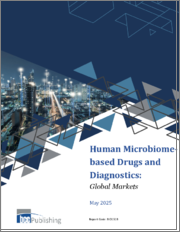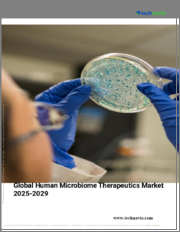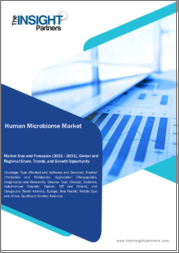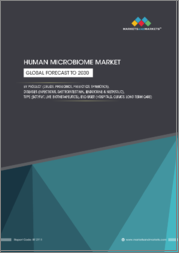
|
시장보고서
상품코드
1600931
인간 마이크로바이옴 시장 : 질환별, 기술별, 제품별, 치료 영역별, 용도별 - 세계 예측(2025-2030년)Human Microbiome Market by Disease (Acute Diarrhea, Autoimmune Disorders, Cancer), Technology (16s rRNA Sequencing, Cell Culture Technology, Computational Tools), Product, Therapeutic Area, Application - Global Forecast 2025-2030 |
||||||
인간 마이크로바이옴 시장은 2023년에 15억 8,000만 달러로 평가되었고 2024년에는 19억 6,000만 달러에 이를 것으로 예측되며, CAGR 23.90%로 성장하여 2030년에는 71억 1,000만 달러에 달할 것으로 예측됩니다.
인간 마이크로바이옴은 세균, 바이러스, 진균, 기타 미생물을 포함한 인체상 및 인체내에 존재하는 미생물 거대한 컨소시엄을 가리킵니다. 그 정의는 소화, 면역, 또 정신적인 행복하게까지 영향을 미치는 인간 건강 중요 요소에까지 미칩니다. 인간 마이크로바이옴을 탐구할 필요성은 건강 치료나 질병 예방에 혁명을 가져올 가능성이 있기 때문입니다. 용도는 맞춤형 의료로부터 프로바이오틱스까지 다방면에 걸쳐, 헬스케어, 제약, 바이오테크놀러지 업계 다양한 최종 용도를 반영하고 있습니다. 시장 인사이트에 의하면, 연구 투자 증가와 미생물에 관련한 건강상 이점에 대한 소비자 의식이, 시장 견고성장을 지지하고 있습니다. 성장에 영향을 미치는 주요 요인으로서는 유전체 배열 결정 기술적 발전, 혁신적인 치료법을 개발하기 위한 바이오테크놀러지 기업과 연구기관 협력 관계 확대등을 들 수 있습니다. 특히, 표적을 좁힌 프로바이오틱스나 프리바이오틱스, 마이크로바이옴 진단, 염증성장질환이나 당뇨병등의 질환에 대한 치료 솔루션 개발에서 비즈니스 기회가 급속히 태어나고 있습니다. 이것들을 활용하기 위해서, 기업은 다이나믹한 파트너십과 지속적연구개발에 주력 해, 마이크로바이옴 제품 주류 용도에의 통합을 추진해야 합니다. 그러나, 비싼 개발비, 규제상 과제, 마이크로바이옴 동태를 이해하는 것 복잡성이라고 하는 제약이, 성장 족쇄가 되고 있습니다. 유전체 데이터에 관한 프라이버시 문제도 장벽이 되고 있습니다. 이러한 과제에 대처하려면, 투명성이 높은 규제 이치와 데이터 정확성과 프라이버시 보호를 강화하기 위한 협력 체제가 필요합니다. 기술 혁신과 연구에 최적인 분야로서는 치료 목적을 위한 합성 공학적 마이크로바이옴, 숙주와 미생물 상호작용을 보다 깊게 이해하기 위한 메타유전체 해석 기술 진보를 들 수 있습니다. 시장은 급속히 발전하고 있어, 각사가 마이크로바이옴데이터를 건강 상태 개선에 유용하게 쓰려고 노력하고 있기 때문에 경쟁적이면서 협조적이다라고 하는 것이 특징입니다. 따라서, 기업은 이 유망한 영역에서 사업 성장을 달성하기 위해서, 제대로 한 조사, 규제에의 인식, 시장 다양화를 조합한 전략적 접근을 채택 해야 합니다.
| 주요 시장 통계 | |
|---|---|
| 기준 연도(2023년) | 15억 8,000만 달러 |
| 예측 연도(2024년) | 19억 6,000만 달러 |
| 예측 연도(2030년) | 71억 1,000만 달러 |
| CAGR(%) | 23.90% |
시장 역학 : 급속히 진화하는 인간 마이크로바이옴 시장 주요 시장 인사이트를 공개
인간 마이크로바이옴 시장은 수요 및 공급 다이나믹한 상호작용에 의해서 변모를 이루고 있습니다. 이러한 시장 역학 진화를 이해하는 것으로, 기업은 충분한 정보에 근거한 투자 결정, 전략적 결정 정치화, 그리고 새로운 비즈니스 기회 획득에 대비할 수 있습니다. 이러한 동향을 종합적으로 파악하는 것으로, 기업은 정치적, 지역 목표, 기술적, 사회적, 경제적인 영역에 건너가는 다양한 리스크를 경감할 수 있어 또한 소비자 행동과 그것이 제조 비용이나 구매 동향에 미치는 영향을 보다 명확하게 이해할 수 있습니다.
- 시장 성장 촉진요인
- 인간 마이크로바이옴 요법 개발에 대한 주목 증가
- Drug Discovery, 병 조기 발견, 진단을 위한 인간 마이크로바이옴
- 프로바이오틱스와 유아 영양 마이크로바이옴에 대한 수요 증가
- 시장 성장 억제요인
- 마이크로바이옴 치료제에 관한 한정된 전문 지식과 안전성 문제
- 시장 기회
- 공동 연구 및 연구 투자 증가에 의한 성장 기회 창출
- 신규 인간 마이크로바이옴 치료제 개발
- 시장이 해결해야 할 과제
- 세균종수 파악 한계와 인간 마이크로바이옴에 근거한 의약품 불확실성
Porter's Five Forces : 인간 마이크로바이옴 시장을 안내하는 전략 툴
Porter's Five Forces 프레임워크는 시장 구도 경쟁 구도를 이해하기 위한 중요 툴입니다. Porter's Five Forces·프레임워크는 기업 경쟁력을 평가해, 전략적 기회를 찾기 위한 명확한 방법을 제공합니다. 이 프레임워크는 기업이 시장내 세력도를 평가해, 신규 사업 수익성을 판단하는데 도움이 됩니다. 이러한 통찰에 의해 기업은 자사 강점을 살려, 약점에 대처해, 잠재적인 과제를 회피할 수 있어보다 강인한 시장에서의 포지셔닝을 확보할 수 있습니다.
PESTLE 분석 : 인간 마이크로바이옴 시장 외부로부터 영향 파악
외부 거시환경 요인은 인간 마이크로바이옴 시장 실적 역학을 형성하는데 있어서 매우 중요 역할을 완수합니다. 정치적, 경제적, 사회적, 기술적, 법적, 환경적 요인 분석은 이러한 영향을 안내하기 위해서 필요한 정보를 제공합니다. PESTLE 요인을 조사하는 것으로, 기업은 잠재적인 리스크와 기회를 보다 좋게 이해할 수 있습니다. 이 분석에 의해 기업은 규제, 소비자 선호도, 경제 동향 변화를 예측해, 앞을 예측한 적극적인 의사결정을 실시할 준비를 할 수 있습니다.
시장 점유율 분석 인간 마이크로바이옴 시장 경쟁 구도 파악
인간 마이크로바이옴 시장 상세한 시장 점유율 분석에 의해 벤더 실적을 종합적으로 평가할 수 있습니다. 기업은 매출, 고객 기반, 성장률등의 주요 지표를 비교하는 것으로, 경쟁상 포지셔닝을 분명히 할 수 있습니다. 이 분석에 의해 시장 집중, 단편화, 통합 동향이 밝혀져, 벤더는 경쟁이 격화하는 가운데 자사 지위를 높이는 전략적 의사결정을 실시하기 위해서 필요한 지견을 얻을 수 있습니다.
FPNV 포지셔닝·마트릭스인간 마이크로바이옴 시장 벤더 퍼포먼스 평가
FPNV 포지셔닝 매트릭스는 인간 마이크로바이옴 시장에서 벤더를 평가하기 위한 중요 툴입니다. 이 매트릭스에 의해 비즈니스 조직은 벤더 비즈니스 전략과 제품 만족도에 근거해 평가하는 것으로, 목표에 따른 충분한 정보에 근거한 의사결정을 실시할 수 있습니다. 4개 상한은 벤더를 명확하고 정확하게 구분해, 사용자가 전략 목표로 최적인 파트너나 솔루션을 특정하는데 도움이 됩니다.
본 보고서는 주요 주목 분야를 망라한 종합적시장 분석을 제공하고 있습니다 :
1.시장 침투도 : 업계 주요 기업 광범위한 데이터를 포함한 현재 시장 환경 상세한 리뷰.
2.시장 개척도 : 신흥 시장 성장 기회를 특정해, 기존 분야 확대 가능성을 평가해, 향후 성장을 향한 전략적 로드맵을 제공합니다.
3.시장 다양화 : 최근 제품 발매, 미개척 지역, 업계 주요 진보, 시장을 형성하는 전략적 투자를 분석합니다.
4.경쟁 평가와 정보 : 경쟁 구도를 철저하게 분석하고 시장 점유율, 사업 전략, 제품 포트폴리오, 인증, 규제기관 승인, 특허 동향, 주요 기업 기술 진보등을 검증 합니다.
5.제품 개발 및 혁신 : 향후 시장 성장을 가속한다고 기대되는 최첨단 기술, 연구개발 활동, 제품 혁신을 하이라이트 하고 있습니다.
또한 이해관계자가 충분한 정보를 얻은 다음 의사결정 할 수 있도록, 중요 질문에도 답하고 있습니다 :
1.현재 시장 규모와 향후 성장 예측은?
2.최고 투자 기회를 제공하는 제품, 부문, 지역은 어딘가?
3.시장을 형성하는 주요 기술 동향과 규제 영향이란?
4.주요 벤더의 시장 점유율과 경쟁 포지션은?
5.벤더 시장 참여·철퇴 전략 원동력이 되는 수입원과 전략적 기회는 무엇인가?
목차
제1장 서문
제2장 조사 방법
제3장 주요 요약
제4장 시장 개요
제5장 시장 인사이트
- 시장 역학
- 성장 촉진요인
- 성장 억제요인
- 기회
- 과제
- 시장 세분화 분석
- Porter's Five Forces 분석
- PESTEL 분석
- 정치
- 경제
- 사회
- 기술
- 법률
- 환경
제6장 인간 마이크로바이옴 시장 : 질환별
- 급성 설사
- 자가면역질환
- 암
- 당뇨병
- 정신질환
- 비만
제7장 인간 마이크로바이옴 시장 : 기술별
- 16s rRNA Sequencing
- Cell Culture Technology
- Computational Tools
- High-Throughput Technology
- Metagenomic Sequencing
- Omics Technology
제8장 인간 마이크로바이옴 시장 : 제품별
- 진단 기기
- 약물
- 식품
- 프리바이오틱스 및 프로바이오틱스
제9장 인간 마이크로바이옴 시장 : 치료 영역별
- 위장장애
- 대사장애
- 피부 질환
- 여성 건강
제10장 인간 마이크로바이옴 시장 : 용도별
- 진단
- 치료제
제11장 아메리카의 인간 마이크로바이옴 시장
- 아르헨티나
- 브라질
- 캐나다
- 멕시코
- 미국
제12장 아시아태평양의 인간 마이크로바이옴 시장
- 호주
- 중국
- 인도
- 인도네시아
- 일본
- 말레이시아
- 필리핀
- 싱가포르
- 한국
- 대만
- 태국
- 베트남
제13장 유럽, 중동 및 아프리카의 인간 마이크로바이옴 시장
- 덴마크
- 이집트
- 핀란드
- 프랑스
- 독일
- 이스라엘
- 이탈리아
- 네덜란드
- 나이지리아
- 노르웨이
- 폴란드
- 카타르
- 러시아
- 사우디아라비아
- 남아프리카공화국
- 스페인
- 스웨덴
- 스위스
- 터키
- 아랍에미리트(UAE)
- 영국
제14장 경쟁 구도
- 시장 점유율 분석, 2023
- FPNV 포지셔닝 매트릭스, 2023
- 경쟁 시나리오 분석
기업 리스트
- Merck KGaA
- Theriva Biologics, Inc.
- BiomeSense, Inc.
- Metabiomics Corporation
- Exeliom Biosciences SAS
- Ferring B.V.
- Evelo Biosciences, Inc.
- Locus Biosciences, Inc.
- Intralytix, Inc.
- Seres Therapeutics, Inc.
- DuPont de Nemours, Inc.
- Invivo Healthcare
- Vedanta Biosciences, Inc.
- Astarte Medical Partners, Inc
- Synlogic, Inc.
- Finch Therapeutics Group, Inc.
- Rebiotix Inc.
- Osel Inc.
- Second Genome, Inc.
- Enterome Bioscience
- Axial Therapeutics, Inc.
- Viome Life Sciences, Inc.
- Yakult Honsha Co., Ltd.
- Azitra
- Illumina, Inc.
- BiomX Ltd.
- AOBiome, LLC
The Human Microbiome Market was valued at USD 1.58 billion in 2023, expected to reach USD 1.96 billion in 2024, and is projected to grow at a CAGR of 23.90%, to USD 7.11 billion by 2030.
The human microbiome refers to the vast consortium of microorganisms residing on and within the human body, encompassing bacteria, viruses, fungi, and other microbes. Its definition extends to a critical component of human health, influencing digestion, immunity, and even mental well-being. The necessity of exploring the human microbiome is driven by its potential to revolutionize health treatments and disease prevention. Applications span from personalized medicine to probiotics, reflecting diverse end-use arenas in healthcare, pharmaceuticals, and biotechnology industries. The market insights suggest robust growth fueled by increased research investment and consumer awareness of microbiome-related health benefits. Key influencing growth factors include technological advancements in genomic sequencing and growing collaborations between biotech firms and research institutions to develop innovative therapies. Opportunities are emerging rapidly, particularly in developing targeted probiotics and prebiotics, microbiome diagnostics, and therapeutic solutions for diseases like inflammatory bowel disease and diabetes. To capitalize on these, businesses should focus on dynamic partnerships and continuous R&D to drive microbiome-product integration into mainstream applications. However, limitations such as high development costs, regulatory challenges, and the complexity of understanding microbiome dynamics tempers growth. Privacy concerns regarding genomic data also pose barriers. Addressing these challenges requires transparent regulatory pathways and collaborations to enhance data accuracy and privacy protections. The best areas for innovation and research include synthetically engineered microbiomes for therapeutic purposes and advancing techniques in metagenomic analysis to better understand host-microbe interactions. The market is rapidly evolving, marked by a competitive yet collaborative nature as companies strive to harness microbiome data for improving health outcomes. Thus, firms should adopt a strategic approach combining robust research, regulatory awareness, and market diversification to achieve business growth in this promising domain.
| KEY MARKET STATISTICS | |
|---|---|
| Base Year [2023] | USD 1.58 billion |
| Estimated Year [2024] | USD 1.96 billion |
| Forecast Year [2030] | USD 7.11 billion |
| CAGR (%) | 23.90% |
Market Dynamics: Unveiling Key Market Insights in the Rapidly Evolving Human Microbiome Market
The Human Microbiome Market is undergoing transformative changes driven by a dynamic interplay of supply and demand factors. Understanding these evolving market dynamics prepares business organizations to make informed investment decisions, refine strategic decisions, and seize new opportunities. By gaining a comprehensive view of these trends, business organizations can mitigate various risks across political, geographic, technical, social, and economic domains while also gaining a clearer understanding of consumer behavior and its impact on manufacturing costs and purchasing trends.
- Market Drivers
- Increased Focus on Development of Human Microbiome Therapy
- Human Microbiome for Drug Discovery, Early Disease Detection, and Diagnosis
- Increasing Demand for Microbiome in Probiotics and Infant Nutrition
- Market Restraints
- Limited Expertise and Safety Issue related to Microbiome Therapeutics
- Market Opportunities
- Increasing Collaborations and Research Investments to Create Growth Opportunities
- Development of Novel Human Microbiome Therapeutic Products
- Market Challenges
- Limitations in Understanding Number of Bacterial Species and Uncertainty of Human Microbiome-Based Drugs
Porter's Five Forces: A Strategic Tool for Navigating the Human Microbiome Market
Porter's five forces framework is a critical tool for understanding the competitive landscape of the Human Microbiome Market. It offers business organizations with a clear methodology for evaluating their competitive positioning and exploring strategic opportunities. This framework helps businesses assess the power dynamics within the market and determine the profitability of new ventures. With these insights, business organizations can leverage their strengths, address weaknesses, and avoid potential challenges, ensuring a more resilient market positioning.
PESTLE Analysis: Navigating External Influences in the Human Microbiome Market
External macro-environmental factors play a pivotal role in shaping the performance dynamics of the Human Microbiome Market. Political, Economic, Social, Technological, Legal, and Environmental factors analysis provides the necessary information to navigate these influences. By examining PESTLE factors, businesses can better understand potential risks and opportunities. This analysis enables business organizations to anticipate changes in regulations, consumer preferences, and economic trends, ensuring they are prepared to make proactive, forward-thinking decisions.
Market Share Analysis: Understanding the Competitive Landscape in the Human Microbiome Market
A detailed market share analysis in the Human Microbiome Market provides a comprehensive assessment of vendors' performance. Companies can identify their competitive positioning by comparing key metrics, including revenue, customer base, and growth rates. This analysis highlights market concentration, fragmentation, and trends in consolidation, offering vendors the insights required to make strategic decisions that enhance their position in an increasingly competitive landscape.
FPNV Positioning Matrix: Evaluating Vendors' Performance in the Human Microbiome Market
The Forefront, Pathfinder, Niche, Vital (FPNV) Positioning Matrix is a critical tool for evaluating vendors within the Human Microbiome Market. This matrix enables business organizations to make well-informed decisions that align with their goals by assessing vendors based on their business strategy and product satisfaction. The four quadrants provide a clear and precise segmentation of vendors, helping users identify the right partners and solutions that best fit their strategic objectives.
Key Company Profiles
The report delves into recent significant developments in the Human Microbiome Market, highlighting leading vendors and their innovative profiles. These include Merck KGaA, Theriva Biologics, Inc., BiomeSense, Inc., Metabiomics Corporation, Exeliom Biosciences SAS, Ferring B.V., Evelo Biosciences, Inc., Locus Biosciences, Inc., Intralytix, Inc., Seres Therapeutics, Inc., DuPont de Nemours, Inc., Invivo Healthcare, Vedanta Biosciences, Inc., Astarte Medical Partners, Inc, Synlogic, Inc., Finch Therapeutics Group, Inc., Rebiotix Inc., Osel Inc., Second Genome, Inc., Enterome Bioscience, Axial Therapeutics, Inc., Viome Life Sciences, Inc., Yakult Honsha Co., Ltd., Azitra, Illumina, Inc., BiomX Ltd., and AOBiome, LLC.
Market Segmentation & Coverage
This research report categorizes the Human Microbiome Market to forecast the revenues and analyze trends in each of the following sub-markets:
- Based on Disease, market is studied across Acute Diarrhea, Autoimmune Disorders, Cancer, Diabetes, Mental Disorders, and Obesity.
- Based on Technology, market is studied across 16s rRNA Sequencing, Cell Culture Technology, Computational Tools, High-Throughput Technology, Metagenomic Sequencing, and Omics Technology.
- Based on Product, market is studied across Diagnostic Devices, Drugs, Foods, and Prebiotic & Probiotics.
- Based on Therapeutic Area, market is studied across Gastrointestinal Disorders, Metabolic Disorders, Skin Disorders, and Women's Health.
- Based on Application, market is studied across Diagnostics and Therapeutics.
- Based on Region, market is studied across Americas, Asia-Pacific, and Europe, Middle East & Africa. The Americas is further studied across Argentina, Brazil, Canada, Mexico, and United States. The United States is further studied across California, Florida, Illinois, New York, Ohio, Pennsylvania, and Texas. The Asia-Pacific is further studied across Australia, China, India, Indonesia, Japan, Malaysia, Philippines, Singapore, South Korea, Taiwan, Thailand, and Vietnam. The Europe, Middle East & Africa is further studied across Denmark, Egypt, Finland, France, Germany, Israel, Italy, Netherlands, Nigeria, Norway, Poland, Qatar, Russia, Saudi Arabia, South Africa, Spain, Sweden, Switzerland, Turkey, United Arab Emirates, and United Kingdom.
The report offers a comprehensive analysis of the market, covering key focus areas:
1. Market Penetration: A detailed review of the current market environment, including extensive data from top industry players, evaluating their market reach and overall influence.
2. Market Development: Identifies growth opportunities in emerging markets and assesses expansion potential in established sectors, providing a strategic roadmap for future growth.
3. Market Diversification: Analyzes recent product launches, untapped geographic regions, major industry advancements, and strategic investments reshaping the market.
4. Competitive Assessment & Intelligence: Provides a thorough analysis of the competitive landscape, examining market share, business strategies, product portfolios, certifications, regulatory approvals, patent trends, and technological advancements of key players.
5. Product Development & Innovation: Highlights cutting-edge technologies, R&D activities, and product innovations expected to drive future market growth.
The report also answers critical questions to aid stakeholders in making informed decisions:
1. What is the current market size, and what is the forecasted growth?
2. Which products, segments, and regions offer the best investment opportunities?
3. What are the key technology trends and regulatory influences shaping the market?
4. How do leading vendors rank in terms of market share and competitive positioning?
5. What revenue sources and strategic opportunities drive vendors' market entry or exit strategies?
Table of Contents
1. Preface
- 1.1. Objectives of the Study
- 1.2. Market Segmentation & Coverage
- 1.3. Years Considered for the Study
- 1.4. Currency & Pricing
- 1.5. Language
- 1.6. Stakeholders
2. Research Methodology
- 2.1. Define: Research Objective
- 2.2. Determine: Research Design
- 2.3. Prepare: Research Instrument
- 2.4. Collect: Data Source
- 2.5. Analyze: Data Interpretation
- 2.6. Formulate: Data Verification
- 2.7. Publish: Research Report
- 2.8. Repeat: Report Update
3. Executive Summary
4. Market Overview
5. Market Insights
- 5.1. Market Dynamics
- 5.1.1. Drivers
- 5.1.1.1. Increased Focus on Development of Human Microbiome Therapy
- 5.1.1.2. Human Microbiome for Drug Discovery, Early Disease Detection, and Diagnosis
- 5.1.1.3. Increasing Demand for Microbiome in Probiotics and Infant Nutrition
- 5.1.2. Restraints
- 5.1.2.1. Limited Expertise and Safety Issue related to Microbiome Therapeutics
- 5.1.3. Opportunities
- 5.1.3.1. Increasing Collaborations and Research Investments to Create Growth Opportunities
- 5.1.3.2. Development of Novel Human Microbiome Therapeutic Products
- 5.1.4. Challenges
- 5.1.4.1. Limitations in Understanding Number of Bacterial Species and Uncertainty of Human Microbiome-Based Drugs
- 5.1.1. Drivers
- 5.2. Market Segmentation Analysis
- 5.2.1. Technology: Recent advancements in 16s rRNA sequencing and omics technology to investigate molecular factors and processes in human body
- 5.2.2. Application: The increasing adoption of the human microbiome in healthcare diagnostics and therapeutics to cater to various health conditions
- 5.3. Porter's Five Forces Analysis
- 5.3.1. Threat of New Entrants
- 5.3.2. Threat of Substitutes
- 5.3.3. Bargaining Power of Customers
- 5.3.4. Bargaining Power of Suppliers
- 5.3.5. Industry Rivalry
- 5.4. PESTLE Analysis
- 5.4.1. Political
- 5.4.2. Economic
- 5.4.3. Social
- 5.4.4. Technological
- 5.4.5. Legal
- 5.4.6. Environmental
- 5.5. Client Customization
- 5.5.1. Intellectual Property Landscape
6. Human Microbiome Market, by Disease
- 6.1. Introduction
- 6.2. Acute Diarrhea
- 6.3. Autoimmune Disorders
- 6.4. Cancer
- 6.5. Diabetes
- 6.6. Mental Disorders
- 6.7. Obesity
7. Human Microbiome Market, by Technology
- 7.1. Introduction
- 7.2. 16s rRNA Sequencing
- 7.3. Cell Culture Technology
- 7.4. Computational Tools
- 7.5. High-Throughput Technology
- 7.6. Metagenomic Sequencing
- 7.7. Omics Technology
8. Human Microbiome Market, by Product
- 8.1. Introduction
- 8.2. Diagnostic Devices
- 8.3. Drugs
- 8.4. Foods
- 8.5. Prebiotic & Probiotics
9. Human Microbiome Market, by Therapeutic Area
- 9.1. Introduction
- 9.2. Gastrointestinal Disorders
- 9.3. Metabolic Disorders
- 9.4. Skin Disorders
- 9.5. Women's Health
10. Human Microbiome Market, by Application
- 10.1. Introduction
- 10.2. Diagnostics
- 10.3. Therapeutics
11. Americas Human Microbiome Market
- 11.1. Introduction
- 11.2. Argentina
- 11.3. Brazil
- 11.4. Canada
- 11.5. Mexico
- 11.6. United States
12. Asia-Pacific Human Microbiome Market
- 12.1. Introduction
- 12.2. Australia
- 12.3. China
- 12.4. India
- 12.5. Indonesia
- 12.6. Japan
- 12.7. Malaysia
- 12.8. Philippines
- 12.9. Singapore
- 12.10. South Korea
- 12.11. Taiwan
- 12.12. Thailand
- 12.13. Vietnam
13. Europe, Middle East & Africa Human Microbiome Market
- 13.1. Introduction
- 13.2. Denmark
- 13.3. Egypt
- 13.4. Finland
- 13.5. France
- 13.6. Germany
- 13.7. Israel
- 13.8. Italy
- 13.9. Netherlands
- 13.10. Nigeria
- 13.11. Norway
- 13.12. Poland
- 13.13. Qatar
- 13.14. Russia
- 13.15. Saudi Arabia
- 13.16. South Africa
- 13.17. Spain
- 13.18. Sweden
- 13.19. Switzerland
- 13.20. Turkey
- 13.21. United Arab Emirates
- 13.22. United Kingdom
14. Competitive Landscape
- 14.1. Market Share Analysis, 2023
- 14.2. FPNV Positioning Matrix, 2023
- 14.3. Competitive Scenario Analysis
- 14.3.1. Clinical Microbiomics Announces Merger with CosmosID
- 14.3.2. Nestle Partners APC Microbiome on Health and Wellbeing Products
- 14.3.3. UW Medicine Launches a New Center to Study Microbiomes
Companies Mentioned
- 1. Merck KGaA
- 2. Theriva Biologics, Inc.
- 3. BiomeSense, Inc.
- 4. Metabiomics Corporation
- 5. Exeliom Biosciences SAS
- 6. Ferring B.V.
- 7. Evelo Biosciences, Inc.
- 8. Locus Biosciences, Inc.
- 9. Intralytix, Inc.
- 10. Seres Therapeutics, Inc.
- 11. DuPont de Nemours, Inc.
- 12. Invivo Healthcare
- 13. Vedanta Biosciences, Inc.
- 14. Astarte Medical Partners, Inc
- 15. Synlogic, Inc.
- 16. Finch Therapeutics Group, Inc.
- 17. Rebiotix Inc.
- 18. Osel Inc.
- 19. Second Genome, Inc.
- 20. Enterome Bioscience
- 21. Axial Therapeutics, Inc.
- 22. Viome Life Sciences, Inc.
- 23. Yakult Honsha Co., Ltd.
- 24. Azitra
- 25. Illumina, Inc.
- 26. BiomX Ltd.
- 27. AOBiome, LLC



















